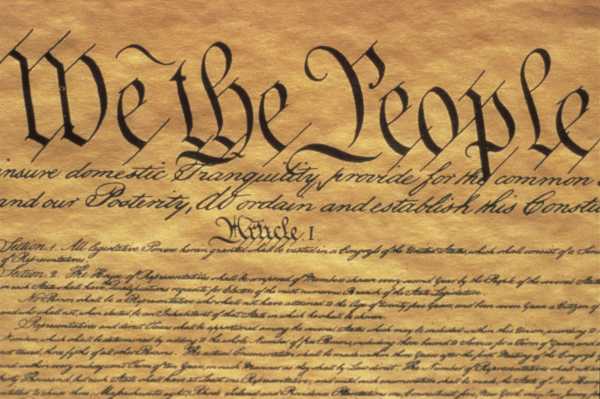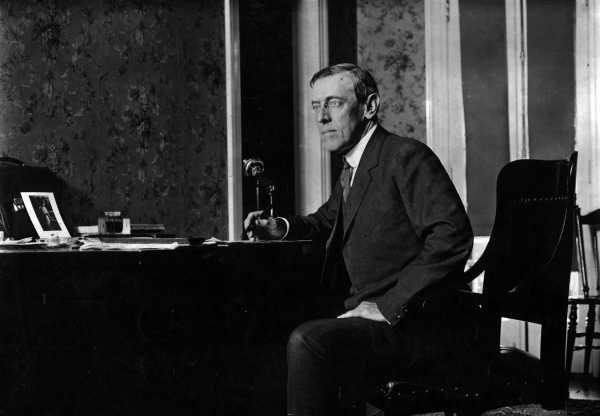
The president of the United States has, legally speaking, a ton of power. He can fire the head of the country’s federal investigative agency. He can decide, unilaterally, to give ultra-classified information to foreign leaders. He has essentially unconstrained authority to use nuclear weapons however he sees fit.
So what would happen if the president were to … not be in his right mind?
According to a New York Times op-ed from an anonymous senior official in Donald Trump’s administration, that question has already come up — and one possible solution was discussed. “There were early whispers within the cabinet,” the official writes, “of invoking the 25th Amendment.”
Specifically, that’s Section 4 of the 25th Amendment to the Constitution. The amendment states that if, for whatever reason, the vice president and a majority of sitting Cabinet secretaries decide that the president is “unable to discharge the powers and duties of his office,” they can simply put that down in writing and send it to two people — the speaker of the House and the Senate’s president pro tem.
Then the vice president would immediately become “Acting President,” and take over all the president’s powers.
Let that sink in — one vice president and any eight Cabinet officers can, theoretically, decide to knock the president out of power at any time.
If the president wants to dispute this move, he can, but then it would be up to Congress to settle the matter with a vote. A two-thirds majority in both houses would be necessary to keep the vice president in charge. If that threshold isn’t reached, the president would regain his powers.
Section 4 of the 25th Amendment has never been invoked in reality, though it’s a staple of thriller fiction. But there’s been a surge of interest in it under Trump, as reports of the president’s bizarre behavior behind closed doors have been piling up, and as his top officials have kept anonymously telling reporters that he’s unfit to govern.
The anonymous Times op-ed, though, claims that the early discussions about invoking it led nowhere, because “no one wanted to precipitate a constitutional crisis.”
Whatever the current circumstances, an enormous amount rests on any president of the United States’ physical and mental health. The 25th Amendment exists as a failsafe that can be used if any president truly does appear to be unwell — as long as the people involved have the courage to actually go through with it, and the competence to carry it out without causing an even greater disaster.
1) Why was the 25th Amendment adopted?

The framers of the Constitution were farsighted about many things, but presidential succession was not among them. The text was vague on several matters, including on whether the vice president fully becomes president if the sitting president dies or resigns (in practice, the answer was interpreted as “yes”), and on how to fill a vice presidential vacancy in the middle of a term (in practice, the answer was interpreted as “you can’t”).
Most interestingly for our purposes, the Constitution’s original text states that a president could be removed from office for “inability” but gives zero specifics about how this would actually be determined or carried out. So when President James Garfield was bedridden after being shot and President Woodrow Wilson was debilitated by a stroke, they simply lingered on in the presidency without doing very much for months, because no one knew what else could be done while they were still drawing breath.
These scenarios may not have been so bad in the United States of the 1790s, but by the mid-20th century the country had become a global superpower, and modern communication tools created omnipresent demands for presidential decisions and actions.
The chaos and instability that followed John F. Kennedy’s assassination finally spurred Congress to move toward solving these problems. For once, it moved quickly, passing what became the 25th Amendment to the Constitution in 1965 and winning its ratification in the states by 1967.
The new amendment cleared up that yes, if a president died or resigned or was convicted of impeachment crimes, the vice president would fully become president. It provided, finally, for a simple way to fill a vacant vice presidency — the president nominates someone, and both Houses of Congress take a vote. It allowed for a president laid low by surgery or injury to voluntarily transfer his powers to the vice president and then easily get them back with a written declaration that he was healthy again.
And then there’s Section 4 — which is about how the vice president and a majority of the Cabinet can deprive the president of his powers without his consent.
2) Wait, the VP and Cabinet can depose the president?
Sort of. There are three major parts to Section 4 of the 25th Amendment. The first part establishes how a president can be quickly stripped of his powers due to inability.
A few notes here. First, the power to sideline the president for inability is given to the vice president and a “majority” of “the principal officers of the executive departments.” (President Reagan’s Justice Department interpreted this to mean the main Cabinet departments, which today number 15.) Theoretically, Congress can also create and empower some “other body” that could make this declaration, but so far it has not done so.
So all the VP and eight Cabinet secretaries have to do is put in writing that the president is “unable” and send that message to the Speaker of the House (currently Paul Ryan) and the Senate’s president pro tem (currently Orrin Hatch). Then the vice president “immediately” takes on the president’s “powers and duties.”
Importantly, though, the veep only becomes “Acting President.” So the elected president hasn’t lost his office yet, just his powers — and not necessarily permanently, as we’ll see in a moment.
Finally, there is zero elaboration on what it would mean for the president to be “unable to discharge the powers and duties of his office.” There is no specification even that it refers solely to health. In theory, it could entail not just physical inability but a judgment call on mental health or even, conceivably, poor character or simple disagreement. It’s really up to the VP and Cabinet to interpret it.
3) But what if the president wants to stay in charge?
Section 4 continues:
This is a mouthful, but the gist is that the president can tell the speaker of the House and Senate president pro tem that he is in fact not unable, and that he wants his powers back. You can imagine this happening if the president regains consciousness from some injury or ailment — or if he simply disagrees that he’s unfit for office.
If he does this, he’ll get his powers back in four days — unless the vice president and at least eight Cabinet officials say, in writing, that he is still unable. Then the vice president will remain in charge for the time being, and Congress will have to step in to settle this dispute. The rest of Section 4 is about this contingency:
So Congress will vote on whether the president is in fact “unable.” If two-thirds of both the House and Senate vote that he is, then the vice president will remain in charge as acting president.
If they fall short of that margin in either House, or simply fail to act within 21 days, the president will regain his powers.
4) In what situations might this actually be used?

Section 4’s text is broad and could apply to a spectrum of different circumstances.
The least controversial scenario would be if a president should become indisputably physically debilitated either from an injury or ailment, so much so that he couldn’t communicate but remained alive. Then it’s a no-brainer to use Section 4 to put the vice president in charge unless and until the president recovers.
But one can also imagine situations in which the president’s physical or mental health is the subject of some dispute — including from the president himself. As a 1988 Miller Center report put it:
Indeed, the topic came up among top administration officials during President Reagan’s second term. In early 1987, White House aide Jim Cannon became intensely disturbed by reports from staffers about how the president had been acting. As he later told Jane Mayer and Doyle McManus:
So Cannon wrote a memo in which he urged White House Chief of Staff Howard Baker to “consider the possibility that section four of the 25th Amendment might be applied.” But it didn’t end up happening — Baker soon decided that Reagan was still in possession of his faculties, and the president remained in office for his full final two years. (Reagan suffered from Alzheimer’s in his later years, and some argue he demonstrated early symptoms while he was in office.)
Finally, the text of the amendment is so vaguely written that it could conceivably be invoked for any reason — even one unrelated to health — so long as enough Cabinet secretaries and the VP are in agreement and two-thirds of both the House and Senate later back them up. For this reason, Section 4 is a favorite of thriller writers concocting scenarios in which malefactors use some bogus pretext to depose the president.
Indeed, the senators who drafted the amendment openly acknowledged that if this power were to be utilized by “rogues,” it could result in “usurpation” of the presidency, as then-Sen. Birch Bayh wrote in a Judiciary Committee report on the proposal.
However, they hoped that since the Cabinet and vice president — “the persons closest to the president, both politically and physically” — are empowered to start this process, that would cut down on any incentives for coup-like mischief. Cabinet secretaries are appointed by the president, after all, so presumably they wouldn’t remove him from power without a really, really good reason. (The Gerald R. Ford Library has posted many fascinating primary source documents on the drafting and passage of the 25th Amendment online at this link.)
5) This sorta feels like a coup. Is it a coup?
I mean, it’s not technically a coup, because it’s indisputably legal and constitutional.
Still, there’s zero precedent for this actually happening in US history, and the vast majority of Americans are likely unaware that it’s even possible. Even savvy political actors or entrenched institutional ones likely aren’t all that familiar with how the amendment is meant to work.
So if a sitting president were to be removed from power by his VP and Cabinet despite his objections, it would sure feel like a coup to a whole lot of people, regardless of the technical legality. And key actors close to the president could well respond like they’re facing a coup. For instance, what would the Secret Service do in this situation? The military?
If the vice president and Cabinet secretaries truly concluded that the president could not remain in office, they would need to document everything that led them to that conclusion and assemble an airtight public case. They would also need to be prepared for the sitting president to resist — either in the court of public opinion or otherwise.
Basically, things could get out of hand really fast. But if the VP and Cabinet feel the situation is dire enough, it could be a risk worth taking.
6) So let’s talk about the elephant in the room.
From the beginning of his presidency, it was clear that Donald Trump was going to govern the same way he campaigned: with a tendency to pick fights and hold grudges, a lack of attention to detail (or, occasionally, fact), and a style that the New York Times has called “shoot-from-the-hip-into-his-own-foot.”
Perhaps the president is a basically rational person who just has a very strange and idiosyncratic personal style. Perhaps he’s just perfectly comfortable repeatedly lying about easily verifiable facts, or profoundly uninterested in examining evidence that conflicts with his assumptions.
But some have wondered whether there could be more going on than the emanations of an idiosyncratic personality.
“I think there is a subtext here that is unlike anything that I have seen in 50 years of being a reporter,” journalist Carl Bernstein said on CNN last year. “And that is that I am hearing from Republicans, and other reporters are as well, that there is open discussion by members of the president of the United States’ own party about his emotional maturity, stability.” He added: “We are in uncharted territory here.”
Conservative New York Times columnist Ross Douthat wrote a May 2017 column calling for the Cabinet to invoke the 25th Amendment, and put it more bluntly: “The presidency now has kinglike qualities, and we have a child upon the throne.”
Diagnosing the president’s mental health from afar is a bad idea, as political partisans can see what they want to see, and the American Psychiatric Association has long cautioned even professional psychiatrists against evaluating anyone they haven’t personally examined.
Yet that’s precisely why the 25th Amendment gives the power to the vice president and the Cabinet secretaries here. Their judgments won’t be skewed by political bias against the president’s party. They work with the president up close and see him in private. So if they see deeply troubling things, they are the ones who have the ability — and, arguably, the responsibility — to act. Much could hinge on whether they do so.
Sourse: vox.com






